Description
Bedini RPX 3.1 MHz Sideband Generator
UNIVERSAL HARMONIC GENERATOR
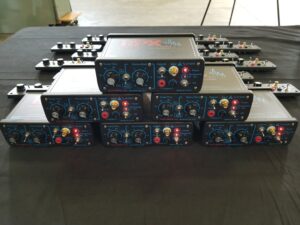
INTERNATIONAL CUSTOMERSYou MUST enter your phone number during checkout as it is required by USPS for shipping to an international address. |
DISCLAIMERThe BEDINI RPX 3.1 MHz SIDEBAND GENERATOR™ is sold for Research Use Only. It is a frequency research device. No claims are given, and the user assumes full responsibility for how they use it. It is up to the buyer to comply with all applicable laws. This product is not intended for human or animal use. It is for research only and is not for medical or clinical applications or diagnostic procedures. There are no medical, curative, or even general wellness or structure/function claims given for this device. There are no other purposes or applications for this device that are claimed or implied in any manner whatsoever. This device is not FDA-approved and cannot be used as a substitute for any medical or therapeutic equipment. This device is intended for personal enjoyment, spiritual or philosophical research, experimental exploration, or recreational use by hobbyists. Frequencies and waveforms produced by this device can, for example, be used in experimental setups involving germinating seeds, plants, or water through electrodes or magnetic coils, aligning with interests in electroculture or frequency research. It can also be used purely for entertainment purposes. By purchasing the BEDINI RPX 3.1 MHz SIDEBAND GENERATOR™, the buyer agrees to the no-refund policy and acknowledges that this device is sold as-is for research use only, with no guarantees of performance or results, and agrees to our Terms & Conditions. This device is provided as-is without any warranty, express or implied, regarding its fitness for any particular purpose, performance, or outcome. |
The Power of Harmonics: Unlocking Energy Through Resonance
Harmonics and the Mystery of Energy Amplification
Harmonics have long fascinated researchers, engineers, and enthusiasts for their ability to amplify energy within systems. Unlike the base frequency, which sets the system into motion, harmonics multiply and redistribute energy, creating effects that often appear disproportionate to the initial input. This amplification is not a violation of physics but is perfectly in alignment with the principles of non-equilibrium thermodynamics, as explained by Ilya Prigogine, the 1977 Nobel Prize winner.
In an open dissipative system, energy flows are not confined but interact with external environmental sources. Harmonics act as a bridge, coupling with these external energy reservoirs, enabling systems to produce what may appear to be over 1.0 COP performance—where the energy output exceeds the operator’s direct input. This isn’t “free energy” or a violation of conservation laws; it’s the efficient harnessing of external energy already present in the environment.
While no claims are being made regarding overunity performance of the RPX 3.1 MHz SIDEBAND GENERATOR™, the principle intrinsic to sideband generators suggests that harmonics inherently amplify energy. This amplification means that the power output of the RPX doesn’t need to be excessively strong to achieve meaningful results—once the power of harmonics is properly understood.
Real-World Examples of Harmonics in Action
1. Opera Singers and the Shattering Glass
The image of an opera singer shattering a wine glass with their voice is more than just a party trick—it’s a vivid demonstration of harmonic energy amplification. The singer’s base note vibrates the glass, but it’s the harmonic overtones that amplify this energy, compounding it to the point of destruction.
- Amplification in Action: The harmonics tap into the structural resonance of the glass, redistributing energy until the cumulative force overwhelms its integrity.
- Beyond Destruction: While harmonics can destabilize structures with undesirable frequencies, they can also reinforce systems with desirable frequencies, amplifying stability and strength.
2. The Tacoma Narrows Bridge Collapse
The collapse of the Tacoma Narrows Bridge in 1940 is one of the most famous cases of harmonic resonance gone wrong. Wind passing over the bridge initiated oscillations, which created harmonic feedback loops. These loops amplified the oscillations exponentially, leading to catastrophic failure.
- Environmental Coupling: The wind served as a small energy input, but the harmonics tapped into the bridge’s natural resonances and structural energy, amplifying the effects far beyond what the wind alone could produce.
- Constructive Potential: Just as harmonics can amplify energy destructively, they can also stabilize systems by aligning with desirable frequencies—a key concept in frequency research.
3. Soldiers Marching on a Bridge
When soldiers cross a bridge, they are often ordered to break step to avoid triggering harmonic resonance. Marching in unison creates rhythmic pulses, transferring small amounts of energy into the bridge. Over time, harmonics compound, amplifying this energy and potentially destabilizing the structure.
- Resonance Cascades: The rhythmic steps act as a base frequency, with harmonics amplifying the oscillations until they overwhelm the bridge’s stability.
- Energy Amplification: This demonstrates how harmonics can appear to produce more energy than the original input, tapping into latent energy within the system.
4. Tesla’s Earthquake Machine
Nikola Tesla’s mechanical oscillator, often called the “Earthquake Machine,” is a legendary example of harnessing harmonics. Tesla discovered that by tuning his oscillator to a structure’s resonant frequency, he could cause vibrations to amplify dramatically. In one experiment, the device reportedly shook an entire building, alarming neighbors.
- Harmonic Multiplication: The oscillator’s small input generated harmonics that amplified vibrations, tapping into the structure’s own energy to magnify the effect.
- Constructive vs. Destructive: Tesla’s work illustrates that harmonics can destabilize systems, but when aligned with beneficial frequencies, they hold immense constructive potential.
Harmonics and Non-Equilibrium Thermodynamics
These examples demonstrate the immense power of harmonics to amplify energy within systems. From shattering glass to collapsing bridges, harmonics reveal how small inputs can create large effects. But why does this happen?
The answer lies in the principles of non-equilibrium thermodynamics, as described by Nobel laureate Ilya Prigogine:
- Open Systems: Harmonics operate in open systems, where energy flows in and out, coupling with external sources such as structural materials, environmental vibrations, or electromagnetic fields.
- Energy Redistribution: Harmonics redistribute energy efficiently, concentrating it in specific resonant modes that amplify the total energy output.
- Over 1.0 COP Performance: This process creates the appearance of overunity, where the energy output exceeds the operator’s input, not because energy is created but because it is drawn from external reservoirs.
Harmonics are not a violation of physics—they are a manifestation of nature’s ability to optimize and amplify energy flows in open dissipative systems.
The RPX 3.1 MHz SIDEBAND GENERATOR™: Exploring the Power of Harmonics
The RPX 3.1 MHz SIDEBAND GENERATOR™ is designed to explore the transformative potential of harmonics. By generating a steady 3.1 MHz carrier frequency and combining it with lower input frequencies, the RPX produces sidebands rich in harmonics, opening a gateway to advanced frequency research.
What Makes the RPX Unique?
- Harmonic Amplification: The RPX allows researchers to study how harmonics amplify energy and interact with systems, revealing their constructive and destructive potential.
- Environmental Coupling: By creating complex harmonic patterns, the RPX demonstrates how frequencies can tap into external energy sources, aligning with principles of non-equilibrium thermodynamics.
- Reinforcing Desirable Frequencies: The RPX provides a platform for exploring how harmonics can stabilize and strengthen systems by aligning with beneficial resonances.
- Efficiency Through Harmonics: With the power of harmonics properly understood, the RPX doesn’t need excessive power output to achieve meaningful results. Its design emphasizes the principle that harmonics amplify energy efficiently, reducing the need for direct power input.
The Mystery and Potential of Harmonics
Harmonics reveal that the true power of frequencies lies not in the base frequency alone but in their ability to amplify energy by coupling with external sources. This phenomenon, grounded in the principles of non-equilibrium thermodynamics, offers a scientifically valid explanation for the overunity-like effects seen in harmonic interactions.
The RPX 3.1 MHz SIDEBAND GENERATOR™ provides a unique platform for researchers, hobbyists, and enthusiasts to delve into the mysteries of harmonics, unlocking new possibilities for resonance, energy, and discovery. By understanding the intrinsic power of harmonics, users can explore how small inputs lead to significant effects, all while aligning with the transformative potential of nature’s energy systems.
Historical Foundations of Frequency Research and Sidebands
The study of frequencies and harmonics has fascinated scientists and engineers for over a century, revealing their profound ability to amplify energy and interact with systems in transformative ways. Across disciplines, pioneers have explored how frequencies can create resonances, generate sidebands, and influence systems at both microscopic and macroscopic levels. These investigations, while often focused on engineering and scientific discovery, have inspired modern tools like the RPX 3.1 MHz SIDEBAND GENERATOR™, which builds on these principles for educational and research purposes only.
1. Nikola Tesla: Resonance and Harmonic Amplification
Tesla’s groundbreaking work with resonance demonstrated the transformative potential of harmonic interactions in mechanical and electromagnetic systems. His Tesla Coil showcased how high-frequency electromagnetic waves could be generated and amplified, while his experiments with mechanical resonance highlighted how harmonic feedback could amplify energy to dramatic levels.
- Key Insights:
- Tesla’s mechanical oscillator leveraged harmonics to amplify small energy inputs, creating large-scale vibrations in structures.
- His work demonstrated how harmonic resonance could redistribute energy efficiently in open systems, laying the foundation for understanding sideband and harmonic phenomena.
Tesla’s research emphasized resonance and energy transfer in engineered systems, not biological or therapeutic contexts.
2. Claude Shannon: The Science of Sidebands in Frequency Modulation
Claude Shannon, the “Father of Information Theory,” contributed significantly to our understanding of frequency modulation (FM) and its creation of sidebands. His work provided the mathematical framework for how carrier frequencies interact with modulating signals to produce a rich spectrum of harmonics.
- Key Insights:
- Shannon showed that modulating a carrier wave with lower frequencies generates sidebands, a key principle in frequency research and telecommunications.
- These principles are crucial for understanding how devices like the RPX produce harmonic complexity through sidebands.
Shannon’s work focused on information transmission but has direct implications for harmonic and frequency research.
3. Modern Spectroscopy: Harmonics in Molecular Research
In modern scientific applications, techniques like vibrational spectroscopy demonstrate the role of harmonics in analyzing molecular systems. These methods use frequencies and their harmonics to study the structure and behavior of complex materials.
- Key Insights:
- Harmonic interactions in molecular resonance provide insights into chemical bonds, material properties, and environmental interactions.
- While unrelated to wellness, this research exemplifies the power of harmonic amplification to reveal hidden details in complex systems.
Spectroscopy’s precise use of harmonics underscores their potential for uncovering new knowledge in a variety of scientific fields.
4. Royal Raymond Rife: Sidebands for Biological Research
Royal Raymond Rife’s work represents one of the earliest attempts to apply harmonic sidebands to biological systems. By combining high-frequency carrier waves with modulating signals, he generated harmonic sidebands that he believed could interact with microorganisms. While Rife’s intent was explicitly tied to wellness applications, his method of using harmonic sidebands remains a significant historical contribution to frequency research. The sideband method is the only legitimate “Rife Frequency” methodology.
This video is a tribute to the late John Bedini who developed the simple sideband generator method that demonstrates exactly how Rife and Hoyland created sidebands and used the sweep method. Here is his oscillator using an audio sweep to create sidebands, which are visible on the spectrum analyzer.
- Key Insights:
- Rife’s sideband generation emphasized the use of carrier waves and harmonic frequencies to explore resonance in biological systems.
- The RPX 3.1 MHz SIDEBAND GENERATOR™ can replicate Rife’s waveforms and sideband techniques for educational purposes only, just as it can replicate many other harmonic and sideband methods.
Disclaimer: References to Rife’s work are for historical and educational purposes only. The RPX 3.1 MHz SIDEBAND GENERATOR™ does not make any claims regarding wellness or therapeutic outcomes and is not associated with Rife’s specific research. The RPX is a versatile tool designed for experimental and exploratory research into harmonic interactions and sidebands.
M.O.P.A. Claims
A Master Oscillator Power Amplifier (MOPA) is a radio frequency (RF) system where a stable, low-power oscillator generates a precise frequency signal, which is then amplified by a separate power amplifier stage to drive a load. The oscillator, often crystal-controlled, ensures minimal frequency drift (typically <100 ppm), maintaining signal stability critical for applications like radio communication, etc.
In contrast, a self-oscillator combines signal generation and amplification in a single stage, where the active device (e.g., transistor or tube) oscillates due to feedback, often leading to significant frequency drift (~kHz) influenced by load, temperature, or supply variations.
Claims of certain devices being MOPAs are misleading. Even John Bedini’s own “MOPA” tube devices were actually self-oscillators. Devices using a programmable crystal oscillator at 3.1 MHz, paired with an amplifier, can technically qualify as a MOPA due to the stable oscillator and separate amplification. Therefore, the RPX by itself is a legtimate MOPA although we don’t normally refer to it as one. Historical context, like WWII-era preferences for stable crystal-controlled MOPAs over drifting self-oscillators for military radios, underscores the importance of fixed oscillators. Devices relying on self-oscillation, despite MOPA branding, risk frequency instability, undermining their efficacy for precise RF applications.
The RPX: Continuing the Legacy of Frequency Research
From Tesla’s resonance experiments to Shannon’s mathematical framework and modern molecular studies, frequency research has consistently demonstrated the profound power of harmonics and sidebands. The RPX 3.1 MHz SIDEBAND GENERATOR™ builds on this foundation, providing researchers and enthusiasts a tool to explore these principles.
The RPX is not intended for wellness or therapeutic purposes, but its ability to replicate harmonic and sideband methods—including Rife’s techniques for educational purposes—offers a unique platform for advancing the study of frequencies and their interactions. By embracing this legacy, the RPX invites users to delve into the transformative potential of harmonics and resonance systems.
The Bedini RPX Sideband Generator: A Precision Tool for Sideband Research
The Bedini RPX 3.1 MHz Sideband Generator provides a platform for researchers and enthusiasts to explore the principles of harmonic sidebands. Its internal signal generator sweeps across a wide frequency range, dynamically creating sidebands for countless frequencies. This includes so-called Rife frequencies, the 528 Hz “Love Frequency,” the 432 Hz “A Note,” and others—whether intentional or coincidental—making the RPX a versatile and powerful research tool.
For those wanting even greater precision, the RPX also supports external signal generators, allowing users to input custom audio frequencies for specific sideband creation.
Sideband Calculation Examples
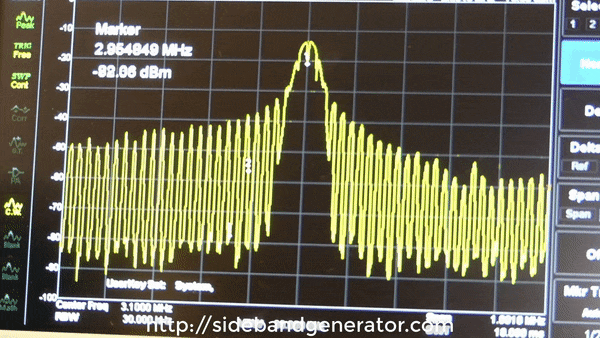 The RPX generates sidebands through the process of heterodyning, combining a stable 3.1 MHz carrier frequency with modulated audio frequencies. The following examples show how to calculate the audio frequency needed to produce sidebands harmonically aligned with specific desired frequencies. This requires an external signal generator – this exact signal generator is proven to work with the RPX: Signal Generator
The RPX generates sidebands through the process of heterodyning, combining a stable 3.1 MHz carrier frequency with modulated audio frequencies. The following examples show how to calculate the audio frequency needed to produce sidebands harmonically aligned with specific desired frequencies. This requires an external signal generator – this exact signal generator is proven to work with the RPX: Signal Generator
Example 1: 528 Hz (Love Frequency)
- Start with the Carrier Frequency: The RPX’s carrier frequency is 3,100,000 Hz (3.1 MHz).
- Divide the Carrier by the Desired Frequency:
3,100,000 ÷ 528 = 5,871.2121... - Round to the Nearest Whole Number:
5,871 - Multiply Back to Find the Closest Harmonic:
5,871 × 528 = 3,099,888 Hz - Calculate the Audio Frequency:
Since3,099,888is less than3,100,000, the audio frequency is:3,100,000 - 3,099,888 = 112 Hz - Input Audio Frequency: Set 112 Hz as the audio frequency on an external signal generator. When mixed with the carrier frequency, this produces sidebands harmonically aligned with 528 Hz.
Example 2: 432 Hz (A Note)
- Start with the Carrier Frequency: The RPX’s carrier frequency is 3,100,000 Hz (3.1 MHz).
- Divide the Carrier by the Desired Frequency:
3,100,000 ÷ 432 = 7,175.93... - Round to the Nearest Whole Number:
7,176 - Multiply Back to Find the Closest Harmonic:
7,176 × 432 = 3,099,840 Hz - Calculate the Audio Frequency:
Since3,099,840is less than3,100,000, the audio frequency is:3,100,000 - 3,099,840 = 160 Hz - Input Audio Frequency: Set 160 Hz as the audio frequency on an external signal generator. When mixed with the carrier frequency, this produces sidebands harmonically aligned with 432 Hz.
Internal Signal Generator and Sweeping Sidebands
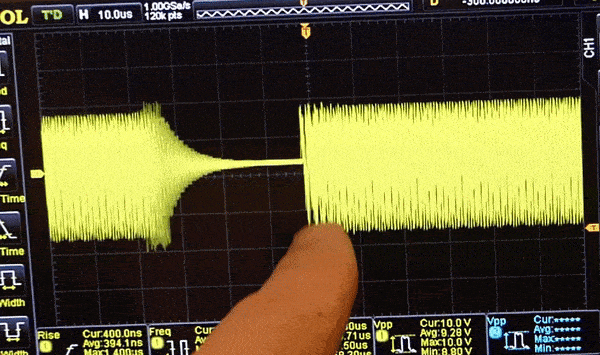 The RPX’s built-in signal generator provides sweeping functionality that modulates audio frequencies from low to high across a broad spectrum. This continuous sweep:
The RPX’s built-in signal generator provides sweeping functionality that modulates audio frequencies from low to high across a broad spectrum. This continuous sweep:
Covers a Wide Range of Frequencies:
Produces sidebands dynamically, ensuring all harmonics and frequencies within the swept range are hit at some point.Coincidentally Hits “Rife Frequencies”:
The sweeping method inherently generates sidebands corresponding to so-called Rife frequencies and many other harmonic targets, without requiring specific input. The animated gif image you see directly above is an accurate demonstration of what the Rife waveform looks like with the high frequency carrier and sidebands having intermittent breaks between them.Simplifies Operation:
Users can rely on the built-in sweeping functionality for broad-spectrum sideband generation, eliminating the need for precise calculations unless specific customization is desired.
Expanding Possibilities with External Generators
For users who want precise control over sideband creation, the RPX supports external signal generators. This capability allows for:
Custom Audio Frequencies:
Input specific frequencies to target harmonics of interest, such as 528 Hz, 432 Hz, or any desired frequency.Refinement of Sideband Amplitude:
Adjust the input audio frequency to ensure sidebands are of sufficient amplitude and free of distortion, as observed with a spectrum analyzer.Innovative Protocols:
Experiment with novel sweep ranges or fixed frequencies to explore unique harmonic configurations.
Applications and Experimental Potential
The RPX provides researchers and enthusiasts with the tools to explore frequency interactions in diverse contexts, including:
Water Structuring:
- Apply sidebands harmonically aligned with frequencies like 528 Hz to water, studying potential changes in molecular or energetic properties.
- Apply sidebands harmonically aligned with frequencies like 528 Hz to water, studying potential changes in molecular or energetic properties.
Plant and Soil Research:
- Direct harmonics into seeds, plants, or soil for electroculture experiments, testing potential influences on growth and vitality.
- Direct harmonics into seeds, plants, or soil for electroculture experiments, testing potential influences on growth and vitality.
Philosophical Exploration:
- Experiment with harmonic frequencies that hold personal, spiritual, or philosophical significance, such as 432 Hz or the Schumann resonance (7.83 Hz).
- Experiment with harmonic frequencies that hold personal, spiritual, or philosophical significance, such as 432 Hz or the Schumann resonance (7.83 Hz).
Harmonic Testing:
- Use the built-in sweeping functionality or external input to explore how harmonic sidebands interact with various experimental systems.
The Signal Generator Misconception: The Real Power Lies in the Sidebands
A common misunderstanding in frequency research, particularly among devices marketed as “Rife machines” and other historical technologies is the overemphasis on base frequencies. Many of these devices are basic signal generators that output static, single frequencies, missing the true potential of harmonic sidebands—where the real transformative energy resides.
The Fallacy of Base Frequencies
- Static Frequencies Are Insufficient:
Base frequencies alone do not exploit the power of harmonic energy amplification. While they initiate oscillations, they lack the dynamic resonance produced by sidebands. - Misalignment with Rife’s Method:
For a historical example, Rife’s approach centered on frequency mixing (heterodyning), where a stable carrier frequency combined with modulated audio signals generates upper and lower sidebands. These sidebands, rich in harmonics, are essential to his method and are entirely absent in devices that rely solely on static signals and do not use sidebands.
Sidebands: The Core of Harmonic Power
- Sidebands redistribute energy dynamically, creating harmonic multiples that interact more effectively with resonant systems.
- They enable energy amplification and resonance coupling, far surpassing the impact of the base frequency alone.
- Devices that fail to generate sidebands miss the opportunity to fully engage with non-equilibrium systems where energy flows can be amplified and optimized.
The Bedini RPX Difference
The Bedini RPX 3.1 MHz Sideband Generator addresses this fundamental oversight by focusing on sideband creation:
- Authentic Sideband Generation:
The RPX produces sidebands using a stable 3.1 MHz carrier frequency combined with sweeping or custom audio frequencies. - Enhanced Harmonic Interaction:
Sidebands generated by the RPX are optimized for amplitude and clarity, ensuring their energy amplification potential is fully realized.
Dispelling the Misconception
The misconception that base frequencies are the most important aspect of frequency research undermines the transformative power of sidebands. Harmonics—not the base frequency—are where the real energy redistribution and amplification occur. By prioritizing sideband generation, the RPX delivers a platform that aligns with the true principles of harmonic frequency research, empowering users to explore these dynamics effectively.
Conclusion: Versatility Meets Precision
The Bedini RPX 3.1 MHz Sideband Generator is a versatile tool for generating harmonics and sidebands. Whether using the internal sweeping functionality or customizing inputs with an external signal generator, the RPX empowers users to explore frequencies like 528 Hz, 432 Hz, and more with precision and creativity.
With its ability to dynamically create sidebands for a wide spectrum of frequencies—including those referred to as “Rife frequencies”—the RPX provides a unique platform for frequency research. Whether exploring water structuring, electroculture, or philosophical concepts, the RPX offers unlimited possibilities for discovery.
Additional Features and Innovations in the RPX
The Bedini RPX 3.1 MHz Sideband Generator offers unique capabilities and refinements, enhancing its utility for educational and experimental frequency research:
Optional Pumpwave Technology:
 The RPX includes a low-frequency carrier wave, known as the Pumpwave, which can be toggled on or off. When enabled, the Pumpwave sequentially “pumps” the generated sidebands, enhancing their delivery and interaction with experimental systems. For studies focused solely on the pure sidebands and harmonics, the Pumpwave can be turned off. It’s essentially a low frequency square wave that the high frequency carrier and sidebands are superimposed upon taking the electrode output to another level.
The RPX includes a low-frequency carrier wave, known as the Pumpwave, which can be toggled on or off. When enabled, the Pumpwave sequentially “pumps” the generated sidebands, enhancing their delivery and interaction with experimental systems. For studies focused solely on the pure sidebands and harmonics, the Pumpwave can be turned off. It’s essentially a low frequency square wave that the high frequency carrier and sidebands are superimposed upon taking the electrode output to another level.
2. Narrow Band Sweeping Option:
In addition to its broad-spectrum sweeping functionality, the RPX features a narrow band option. This allows users to focus on specific frequency ranges, ideal for targeted harmonic research or precise investigations of particular sidebands.
Spectrum Analyzer and Oscilloscope Compatibility:
- Spectrum Analyzer: Connect a spectrum analyzer to observe and measure the generated sidebands and their frequencies. This helps verify proper harmonic alignment and amplitude for experimental applications.
- Oscilloscope: Use an oscilloscope to visualize the actual waveforms being generated, including the carrier frequency, audio input, and resulting sidebands. This adds a layer of analysis for researchers interested in the temporal structure of the signals.
Enhanced External Input Compatibility:
The RPX supports external signal generators, allowing users to input custom audio frequencies. This capability is ideal for calculating and generating tailored sidebands aligned with specific resonances, such as the so-called Rife frequencies or other experimental targets.Customizable Research Options:
The RPX offers unparalleled flexibility, allowing users to:- Switch between broad-spectrum and narrow-spectrum sweeps.
- Use external inputs for custom frequencies.
- Toggle the Pumpwave feature to match specific research requirements.
- Analyze both waveforms and sidebands for comprehensive experimental insights.
Educational Insights and Legacy
The RPX builds on the foundational principles of sideband generation while integrating modern advancements for enhanced research capabilities:
Pumpwave Versatility:
The ability to enable or disable the Pumpwave feature ensures that users can tailor the device to their specific research needs.Advanced Visualization Tools:
Whether observing the harmonic spectrum with a spectrum analyzer or studying signal waveforms with an oscilloscope, the RPX provides researchers with detailed insights into the frequency generation process.
By combining historical principles with modern features, the RPX empowers researchers to explore the transformative potential of harmonics and sidebands with precision and flexibility.
THE SIGNAL GENRATOR IN THE RPX IS 100% ANALOG
NO DIGITAL ELECTRONICS!
The suggested retail price for the RPX is $2495
1 YEAR GUARANTEE
Although we have a NO REFUND policy for these units, we do offer a 1 year guarantee! If at anytime the RPX unit malfunctions within 1 year from the purchase date, contact us for return authorization before sending anything back to us. We will attempt to repair any malfunction and if it is repairable, we will replace said item with a new unit. Any attempt to open any of these devices to repair it yourself without our authorization automatically voids your warranty. Less than 0.5% of the previous edition RPX combos ever had any problems and almost all the problems were with the Chinese signal generators and not with the RPX itself.
MADE IN U.S.A.
Our new RPX™ Sideband Generators are professionally manufactured right here in Spokane, Washington, USA. The quality and workmanship is guaranteed. We choose to employ people in our own hometown and we hope you can appreciate that.
Frequently Asked Questions
What’s included in the box?
With each RPX order, you will receive 1 x RPX unit, 1 x battery charger, 1 x output cable and 1 x instruction sheet.
What kind of electrodes can I get and/or where can I get them?
We just use cheap copper tubing from the hardware store. About 2 pieces that are around 1/2″ diameter and about 3-4 inches long. Just clip the leads to it. Shine them up with a souring pad when they get oxidized. The electrode type is not critical – just needs to be something conductive.
Should we use conductive gel with the electrodes?
Yes, use one that is free of parabens such as this: Conductive Gel
How long should the RPX be used?
15 minutes on the low end and up to 60 minutes at the top end.
How long will the battery last?
When fully charged, you will get many hours of use out of it but it is recommended to charge the battery up after every couple hours of use.
Can the RPX power a plasma tube?
That is a regression in the technology because electrodes with the Bedini Pumpwave obsoletes electromagnetic or plasma output. The RPX does not have enough power to drive a tube.
Can the RPX output be put to a electromagnetic coil?
Yes, it is not as good as electrodes with the Bedini Pumpwave but you can take some insulated wire around 20 AWG and about 40 feet long and wind a spiral that you glue to a piece of plastic or wood. Take the 2 output leads and connect them to the inner and outer leads of the pancake/spiral coil. Silver wire with cotton insulation would be recommended but we cannot assist you in finding any.
Can this be used radionically?
Make a pancake coil as described above and put your witness, etc. on the coil. There are no guarantees as this is all for research and testing.
Can I enter frequencies into the RPX?
Not directly and that would defeat the purpose of having an authentic Rife frequency generator. The audio frequencies sweep from low to high while mixing with a carrier to produce sidebands that are harmonics of the “Rife Frequencies” – that is how Rife and his assistant Hoyland did it and that is how you should create the frequencies too. You can use an external signal generator to input any low frequency you want so that when it mixes with the 3.1MHz carrier, you will create sidebands that are harmonics of your own desired frequency.
How can I calculate what audio frequency to input to create sidebands that are harmonics of my desired frequency?
Use the calculator on this page. Leave 3100000 in the carrier frequency field. Enter your desired frequency in that field such as 432. Press Enter. You will see that you need to use an audio frequency of 32 Hz that mixes with the 3.1 MHz carrier to produce sidebands that are harmonics of 432 Hz. Watch the video on this website that teaches you how to calculate them if you want to learn how to do it without a calculator.
How long is shipping?
If RPX units are in stock, they ship within 24-72 hours and if you’re in the USA, you’ll receive it in about 3 business days. If in Canada or overseas, it will take about 10 business days.
What is the product category for customs?
The harmonized code is for “Signal generators, electrical” is 854320. This code falls under Chapter 85 of the Harmonized System, which covers electrical machinery and equipment. Specifically, it is for “Electrical machines and apparatus, having individual functions, not specified or included elsewhere in this chapter”.
Do you have an export license?
“NOEEI 30.37(a)” is an exemption code used when filing Electronic Export Information (EEI) in the Automated Export System (AES). It signifies that the value of each individual commodity, classified under a specific Schedule B or HTS number, is $2,500 or less, and the shipment does not require a U.S. government export license. The RPX’s NOEEI code is a way to indicate that EEI filing is not required for certain low-value shipments.

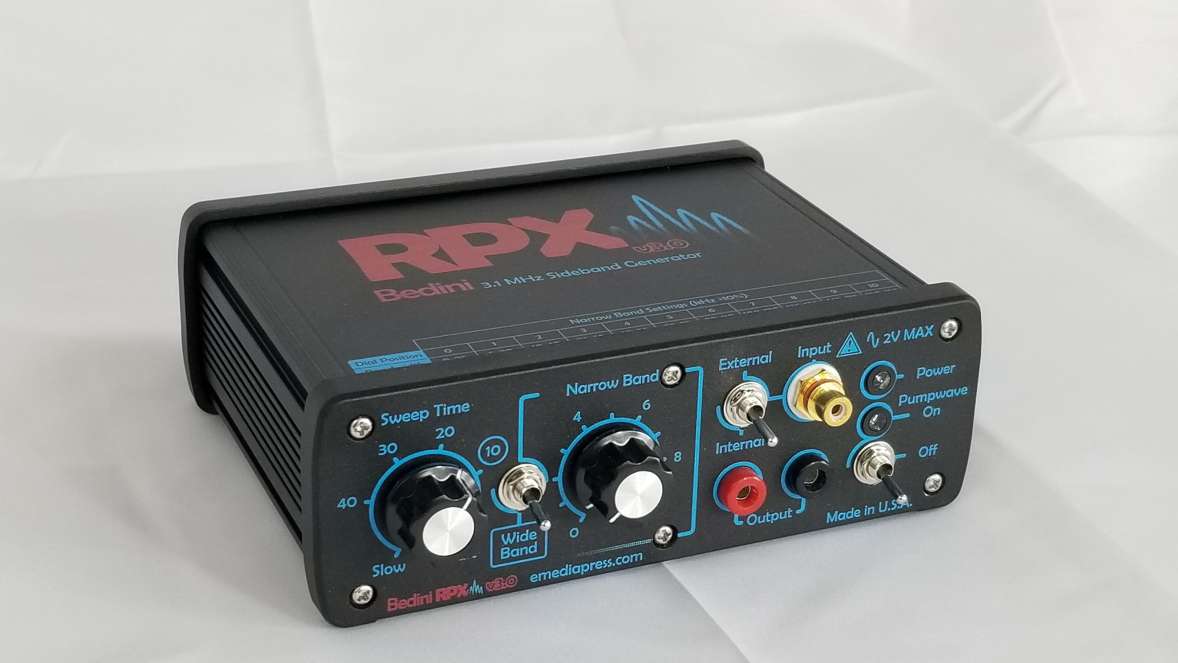
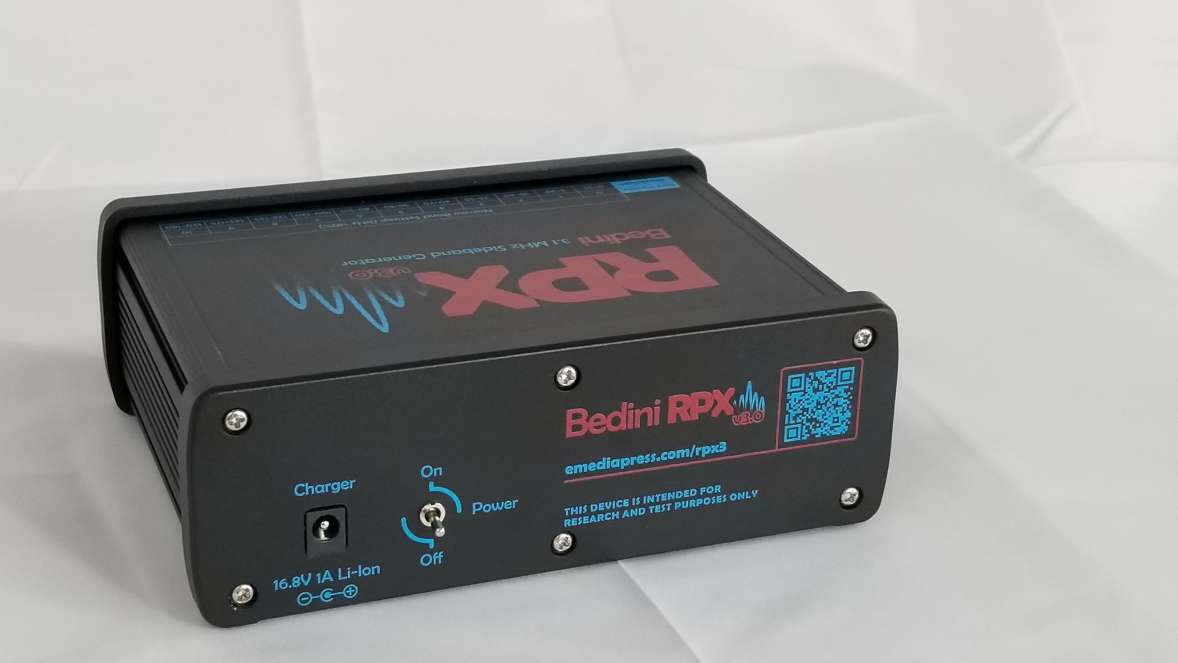


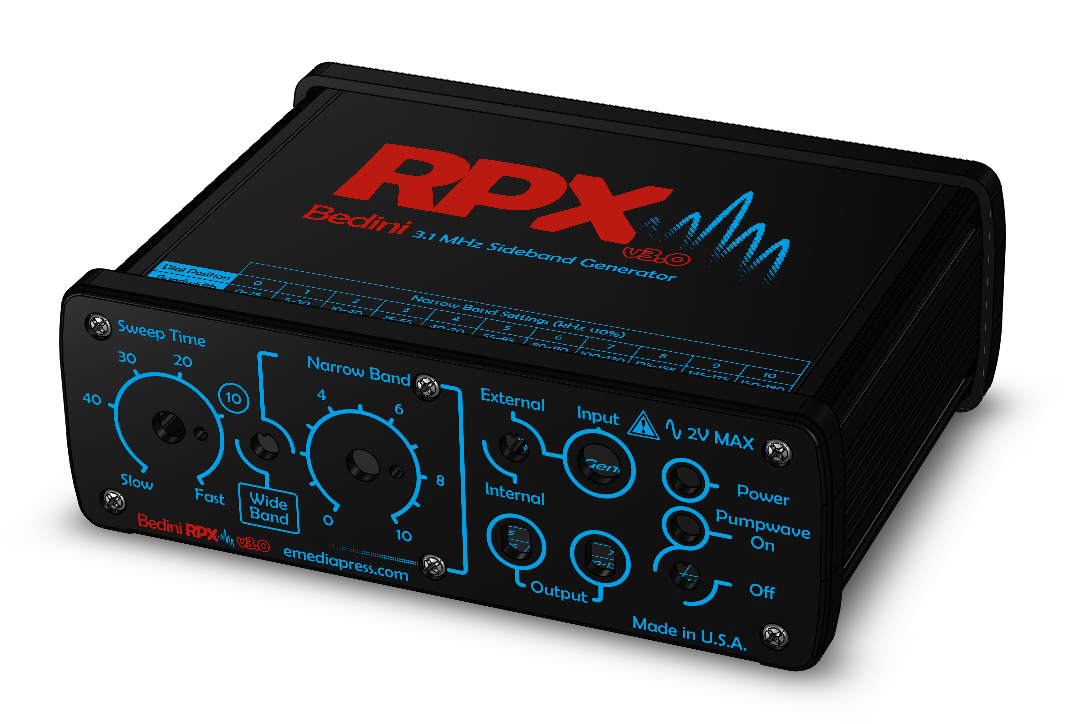
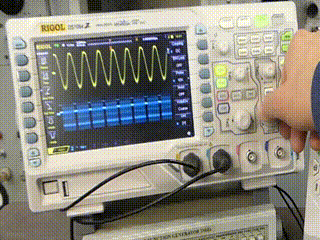 The RPX includes a low-frequency carrier wave, known as the Pumpwave, which can be toggled on or off. When enabled, the Pumpwave sequentially “pumps” the generated sidebands, enhancing their delivery and interaction with experimental systems. For studies focused solely on the pure sidebands and harmonics, the Pumpwave can be turned off. It’s essentially a low frequency square wave that the high frequency carrier and sidebands are superimposed upon taking the electrode output to another level.
The RPX includes a low-frequency carrier wave, known as the Pumpwave, which can be toggled on or off. When enabled, the Pumpwave sequentially “pumps” the generated sidebands, enhancing their delivery and interaction with experimental systems. For studies focused solely on the pure sidebands and harmonics, the Pumpwave can be turned off. It’s essentially a low frequency square wave that the high frequency carrier and sidebands are superimposed upon taking the electrode output to another level. 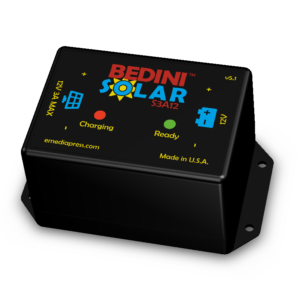
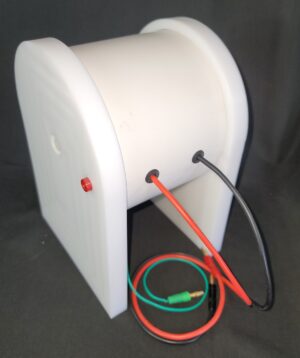
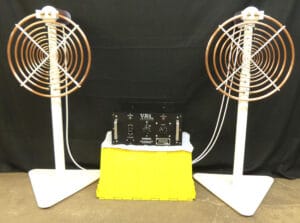
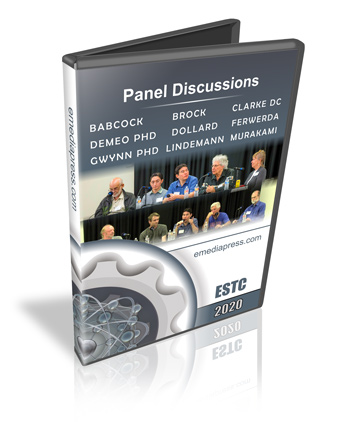



Reviews
There are no reviews yet.